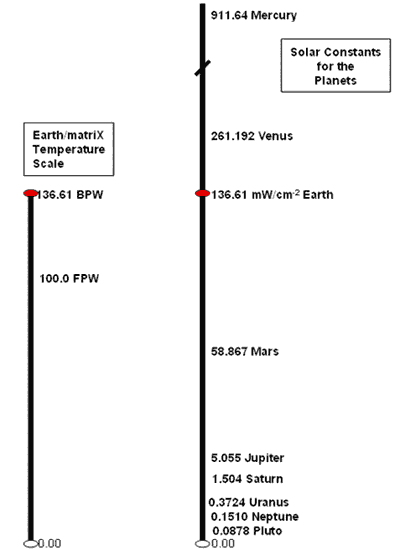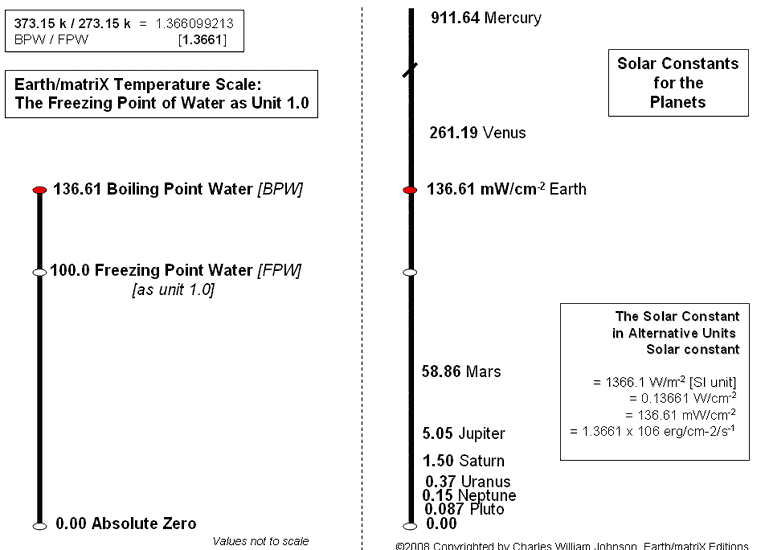
|
The Solar Constants of the Planets
by Charles William Johnson Earth/matriX Editions ©2008-2013 Copyrighted Charles William Johnson.All rights reserved. |
Commentary
I came across this item on the Internet, where the American Society for Testing and Materials developed an AM 0 reference spectrum (ASTM E-490) for use in the aerospace community. It was based on the value of the solar constant of 1366.1 W/m2.
In 2002, I wrote about the solar constant being 1.3661 as of my analysis of the thermodynamic temperature scale. One divides the boiling point of water (373.15 kelvin) by the freezing point of water (273.15 kelvin) and the 1.3661 value obtains. From that, I have been proposing the Earth/matrix thermodynamic temperature scaled based on the freezing point of water as unit 100.0 and the boiling point of water as being 136.61 energy-matter (e-m) units.
[See: http://www.earthmatrix.com/sciencetoday/solar-constant.html]
When I made the Earth/matriX temperature scale proposal, I was aware of the Atlas Mission readings of 1.3661 fractal for the solar constant, but I was unaware of the reference spectrum issued by the American Society for Testing and Materials.
“Standard
Solar Spectra: Air Mass Zero The integrated spectral irradiance has been
made to conform to the value of the solar constant accepted by the space
community; which is 1366.1 W/m2....
rredc.nrel.gov/solar/standards/am0/newam0.html ASTM Standard
Extraterrestrial Spectrum Reference E-490-00
In 1999, the American Society for Testing and Materials developed
an AM 0 reference spectrum (ASTM E-490) for use by the aerospace community.
That ASTM E490 Air Mass Zero solar spectral irradiance is based on data
from satellites, space shuttle missions, high-altitude aircraft, rocket
soundings, ground-based solar telescopes, and modeled spectral irradiance.
The integrated spectral irradiance has been made to conform to the value
of the solar constant accepted by the space community; which is 1366.1
W/m2.”
SOURCE: rredc.nrel.gov/solar/standards/am0/newam0.html -
As I read about the Standard Solar Spectra, it occurred to me that one could illustrate the solar constants of the planets on a relational scale similar to the Earth/matriX thermodynamic Temperature Scale.
The same source [rredc.nrel.gov/solar/standards/am0/newam0.html - ] presents the solar constant in alternative units from the SI unit.
|
TABLE 1. Mean Perihelion Aphelion Mercury 9116.4 14447.5 6271.1 SOURCE: http://rredc.nrel.gov/solar/standards/am0/newam0.html |
 |

From the previous comparison, one can easily identify a relationship between the Earth/matriX thermodynamic temperature scale and the solar constants of the planets. I find it quite logical to observe a relationship of 1.3661 fractal between the boiling and freezing points of water on Earth and the fact that the solar constant for the Earth is a fractal value of 1.3661. Nonetheless, it would appear that others do not find such comparisons to be acceptable in this manner.
Convention makes it difficult for scientists to consider employing a temperature scale based on the freezing point of water as unit 1.0 (or, 100.0 fractal). It required centuries of research and discovery to produce the celsius and kelvin temperature scales, and general practice in the sciences causes giving up such scales to be quite impossible. Yet, once we identify the unit-1.0 relationship of the Earth/matriX temperatures scales, as I have been proposing since the late 1990s, many other relationships become available. In this case, we are able to identify a relationship between temperature scales and the solar constants of the planets in our solar system.
There are innumerable relationships that become available once the Earth/matriX temperature scales are employed, as I have been pointing out in the essay series at www.earthmatrix.com and .theschemata. Soon other essays will be posted illustrating yet additional comparisons of the data in relation to the Earth/matriX temperature scales. At present, I am finishing a study of the boiling/melting points of the elements, which should offer insight into comparative relationships of the same.
In the meantime, I offer an example of how the Earth/matriX temperature scale may in fact represent a scale for the solar constants of the planets of the solar system, as illustrated in this brief extract.
Earth/matiX
SCIENCE IN ANCIENT ARTWORK AND SCIENCE TODAY
Metairie, Louisiana March 2008
©2008-2013 Copyrighted by Charles William Johnson. All rights reserved.
Earth/matriX Editions,
Email: johnson@earthmatrix.com
| Home | Books | Forum | Reviews | Links | Author |